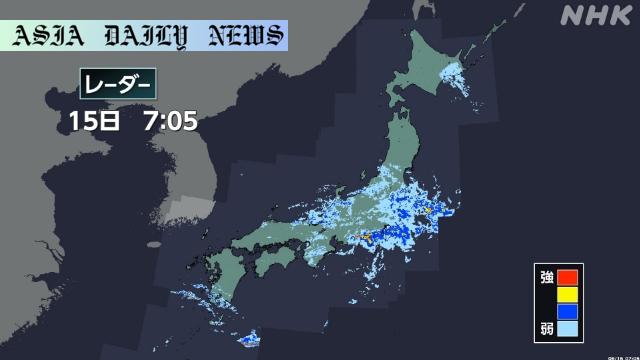Rainfall: Weather officials forecast heavy rains in eastern Japan with landslide warnings in specific areas.
Heavy rainfall with thunder expected in eastern Japan.
Landslide warnings issued for Shizuoka Prefecture.
Warm, moist air fueling a low-pressure system causing rain.
Potential downpours in Kyushu, increasing risks by Tuesday.

Weather Overview: Heavy Rainfall and Thunder Expected
Eastern Japan is currently on alert for intense rainfall accompanied by thunder in various regions including Tokai, Kanto, and Tohoku. The Japan Meteorological Agency attributes this phenomenon to warm, moist air interacting with a low-pressure weather system over the Sea of Japan, resulting in the formation of dense rain clouds. With rainfall rates reaching up to 61 millimeters per hour, as observed in Shimada City, Shizuoka Prefecture, the region faces a substantial threat of disruption due to this ongoing weather situation.
Landslide Risks and Advisory for Vulnerable Zones
The heavy rainfall over the weekend has already caused the soil in certain areas to loosen, raising concerns for landslides. Shizuoka Prefecture has been particularly affected with landslide warnings activated. Residents in low-lying and vulnerable areas are urged to monitor the situation closely, take precautions, and stay informed through reliable weather updates. The risk of flooding and river swells also increases exponentially in such severe conditions, making it imperative for everyone in the affected regions to exercise caution.
Kyushu Briefed for Recurring Rain
Meanwhile, Kyushu, which recently experienced relief from heavy rain, may not be out of danger just yet. Meteorologists predict that the intensity of rainfall could rebound through Tuesday, potentially reinstating the risk of downpours in the area. With the region already burdened by saturated ground, additional rain could exacerbate existing vulnerabilities. Authorities are emphasizing preventive actions to reduce damage, especially to infrastructure and agriculture.
Impact of Weather Systems and Safety Measures
The current weather conditions are an outcome of natural systems that interact dynamically, including a low-pressure system, warm air influx, and moisture over the Sea of Japan. These systems often result in unpredictable rainfall patterns and intensity. Experts predict over 30 millimeters per hour of rain occurring intermittently across various regions. It is advisable for residents to avoid unnecessary travel, secure their homes, and heed evacuation orders if issued. Such proactive steps will significantly reduce the likelihood of injuries or fatalities and damage to property.
Conclusion
As the weather conditions continue to pose risks, it is vital for residents in eastern Japan and nearby areas to stay informed by monitoring alerts from the Japan Meteorological Agency. With landslides, flooding, and swollen rivers remaining a concern, collective vigilance is essential in navigating these challenging circumstances. Ensuring community safety and preparedness will play a crucial role in minimizing the impact of such natural events.
Commentary
Understanding the Severity of Weather Warnings
The recent warnings issued for rainfall and possible landslides in eastern Japan serve as yet another reminder of the unpredictable power of nature. It is incredible how weather systems, driven by warm moist air and low pressure, can so drastically shape everyday life. More than the inconvenience of a rainy day, this alert emphasizes the pressing hazards that follow – such as landslides and flooding. As communities brace for this event, it urges everyone to respect the power of these natural systems and plan accordingly.
Preparedness and Public Safety
One cannot overstate the importance of public preparedness in the face of such severe weather. From securing properties to adhering to evacuation notices, every small effort can save lives and prevent property damage. It is commendable that officials are taking proactive steps to issue warnings and emphasize precautions such as avoiding rivers, unstable ground, and low-lying areas. Still, the onus is partly on the residents to take these warnings seriously and act swiftly.
Building Long-Term Resilience
These recurring weather patterns point to a larger issue – the need for societies to build stronger resilience against natural disasters. Whether it be through advanced early-warning systems, infrastructural changes, or community training, preparations must evolve alongside changing weather trends. While Japan is globally recognized for its disaster preparedness, there is always room to further integrate technology and community-driven solutions to mitigate risks effectively.


